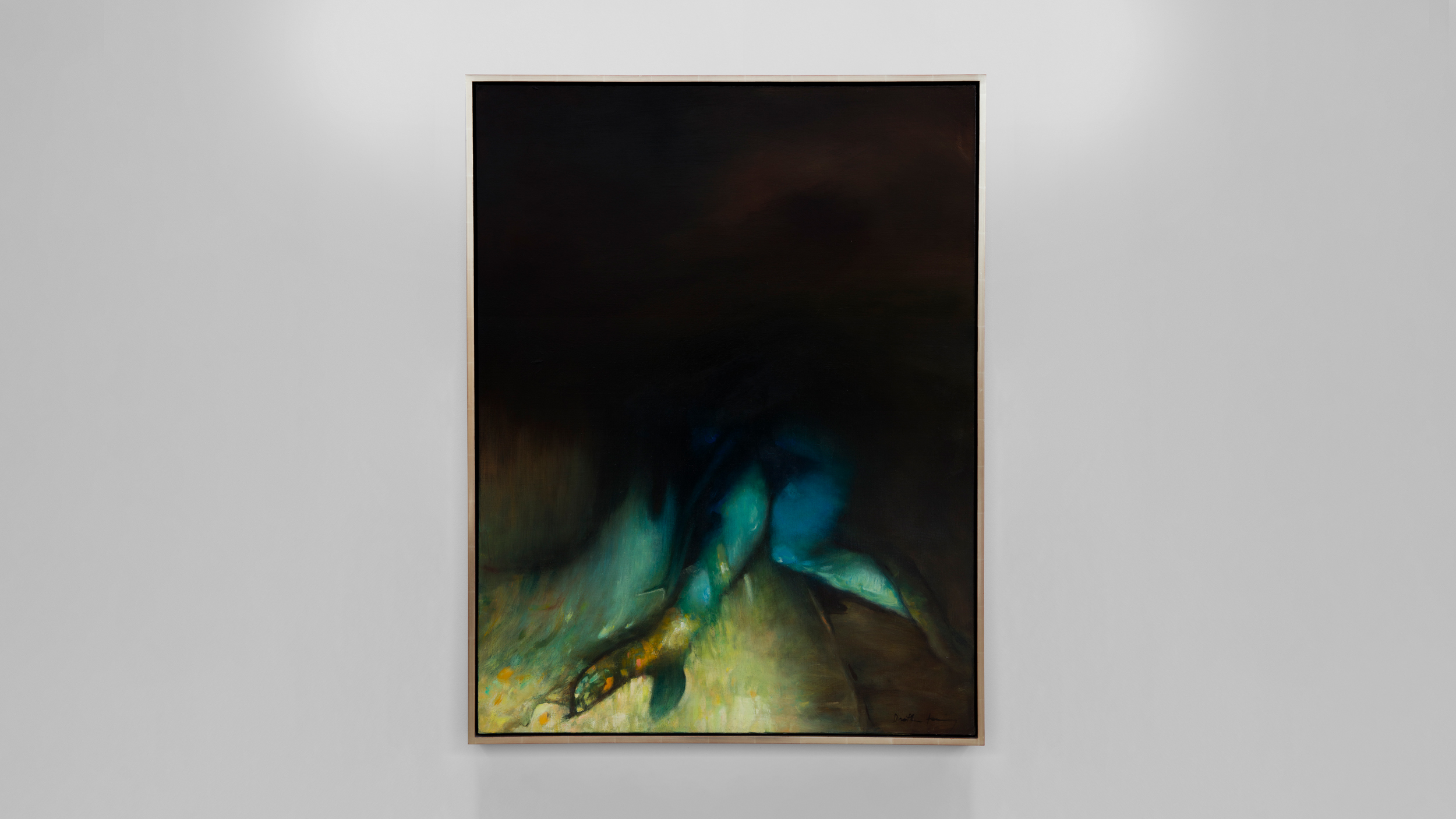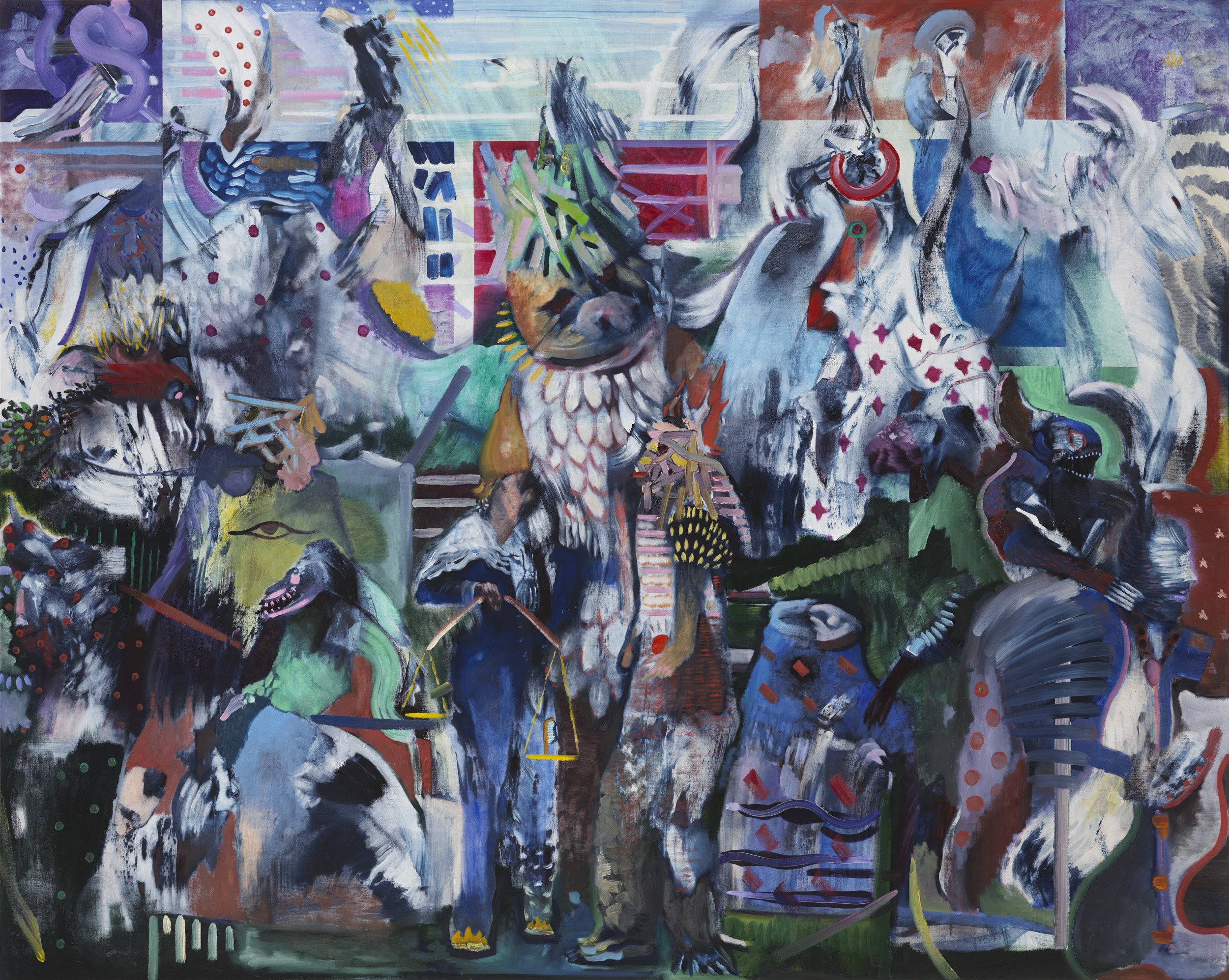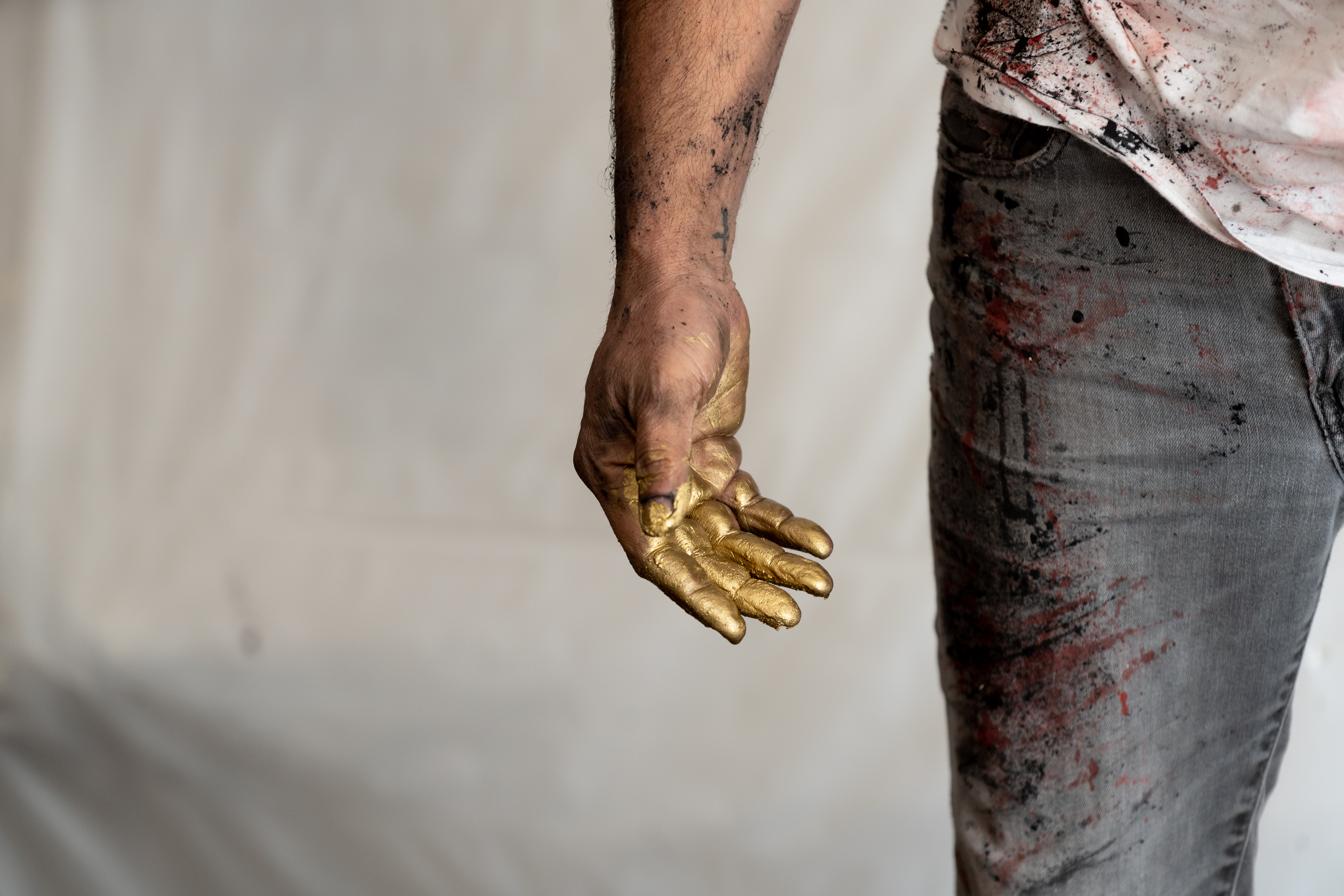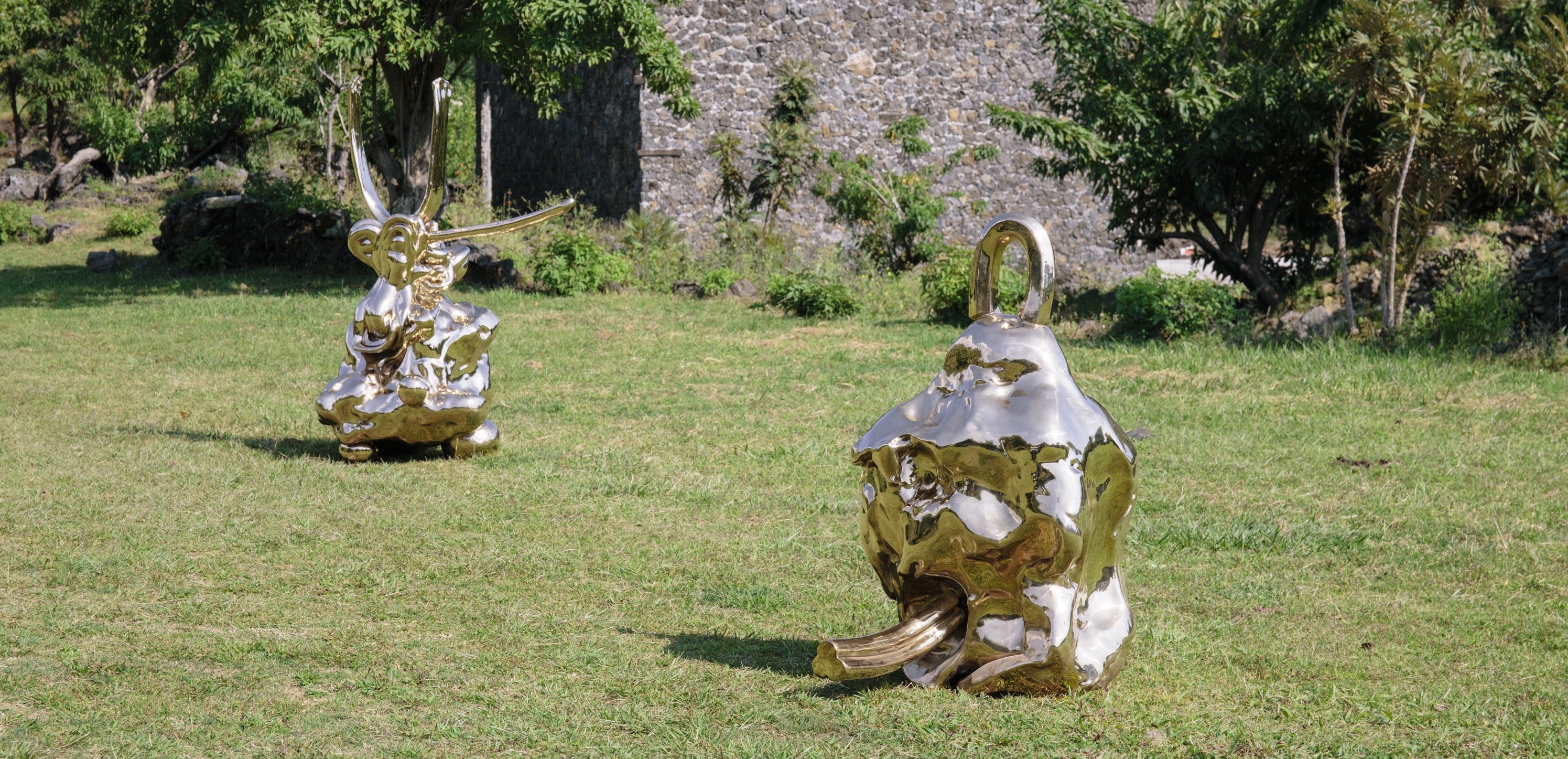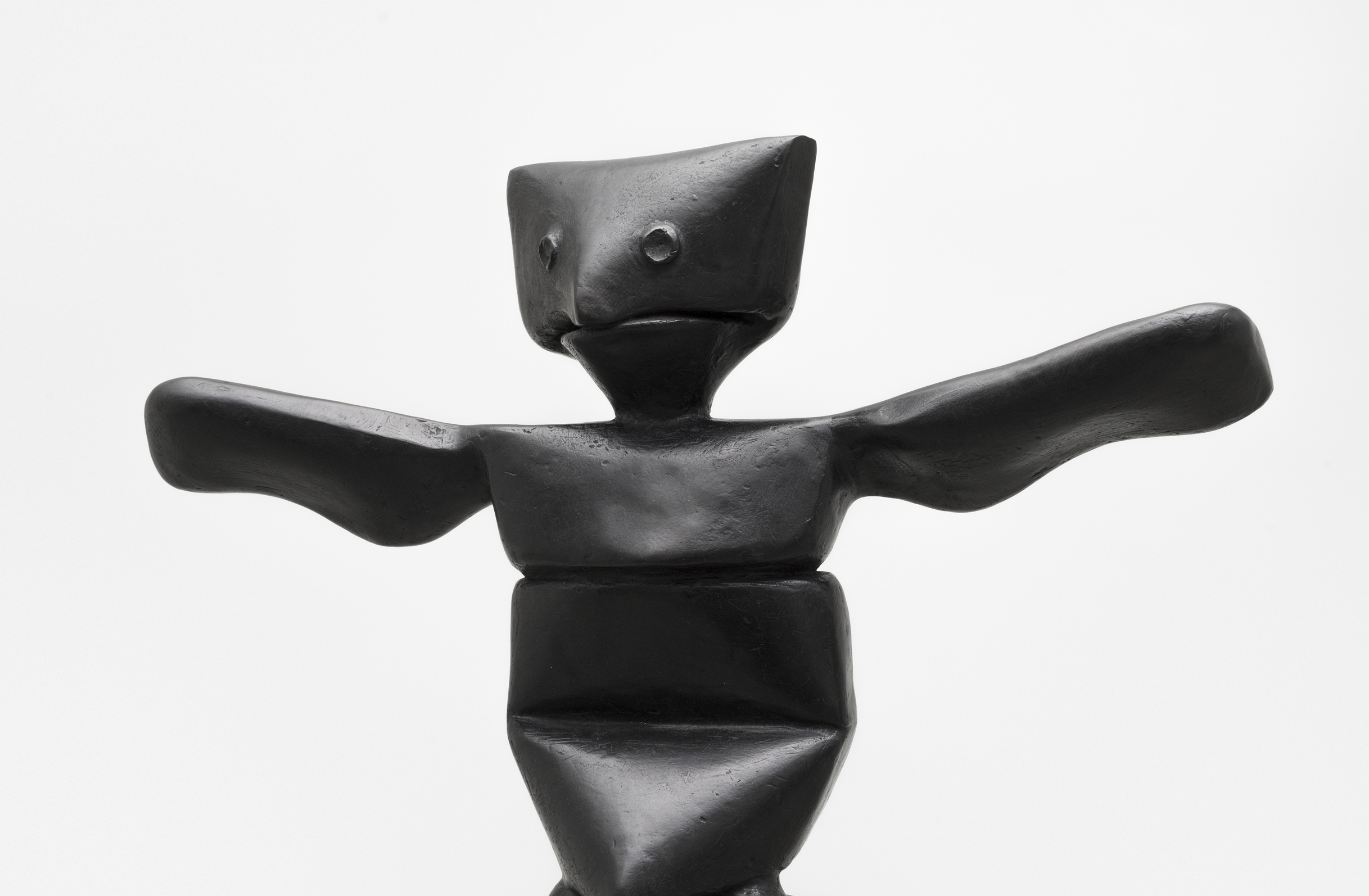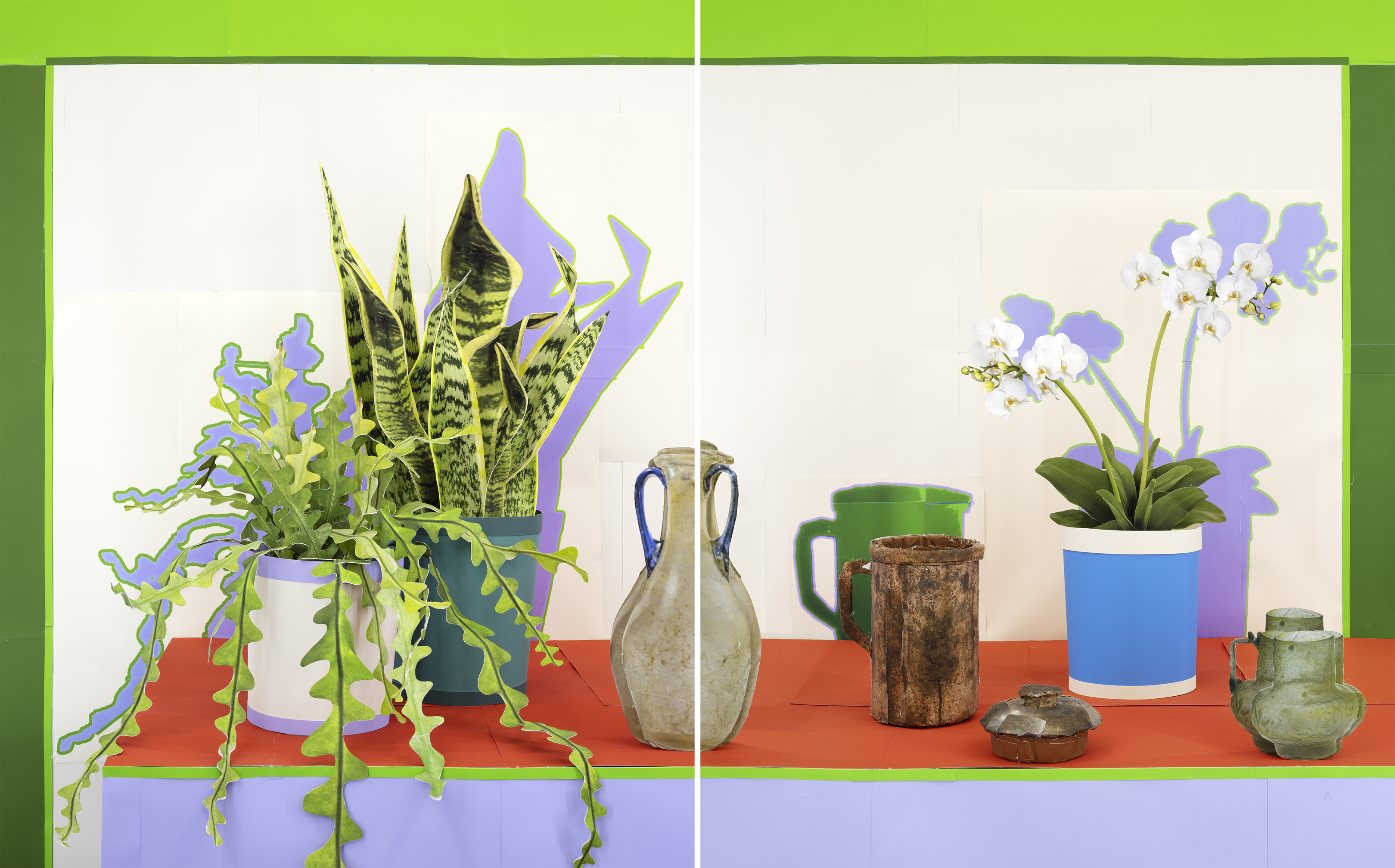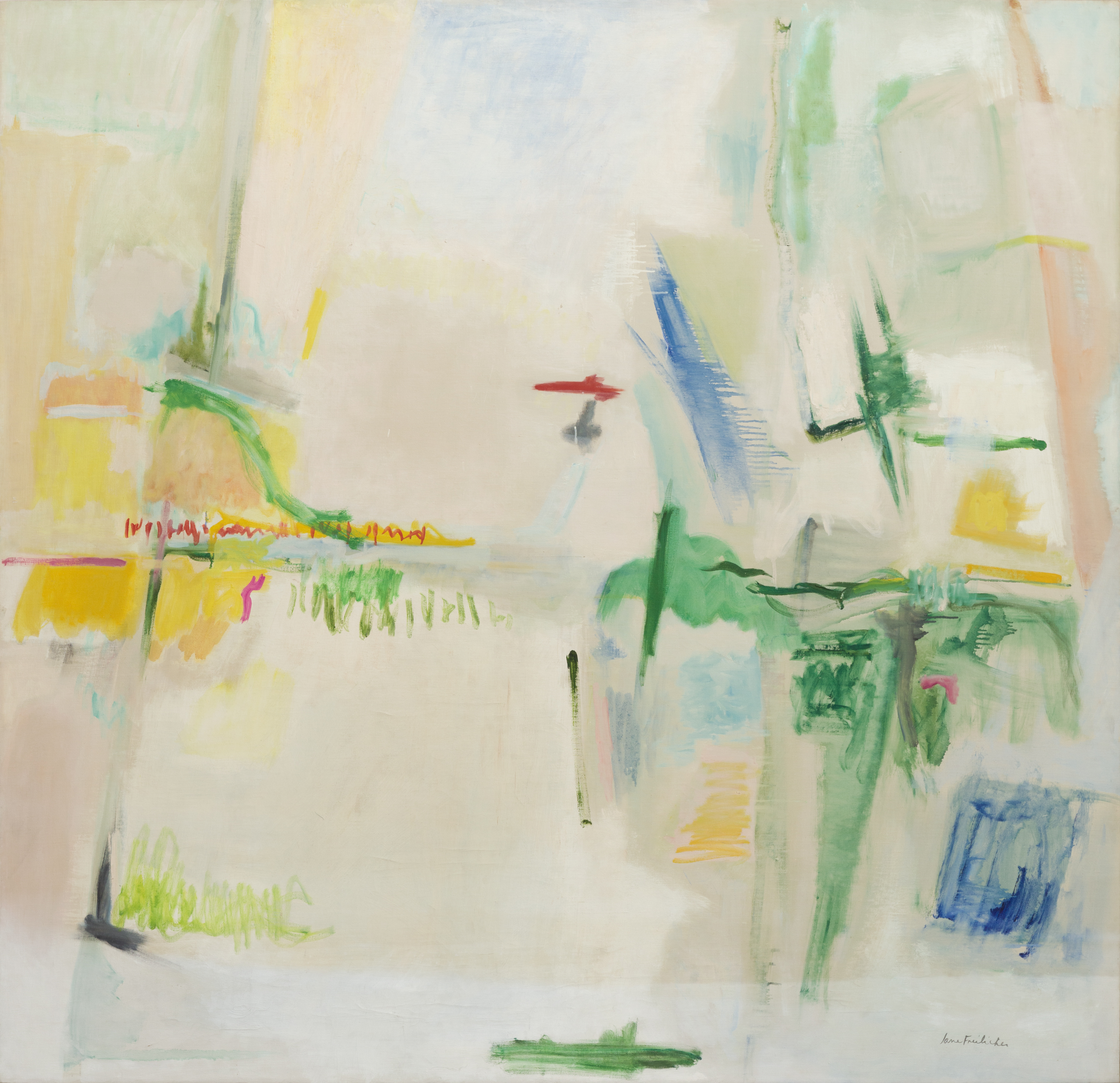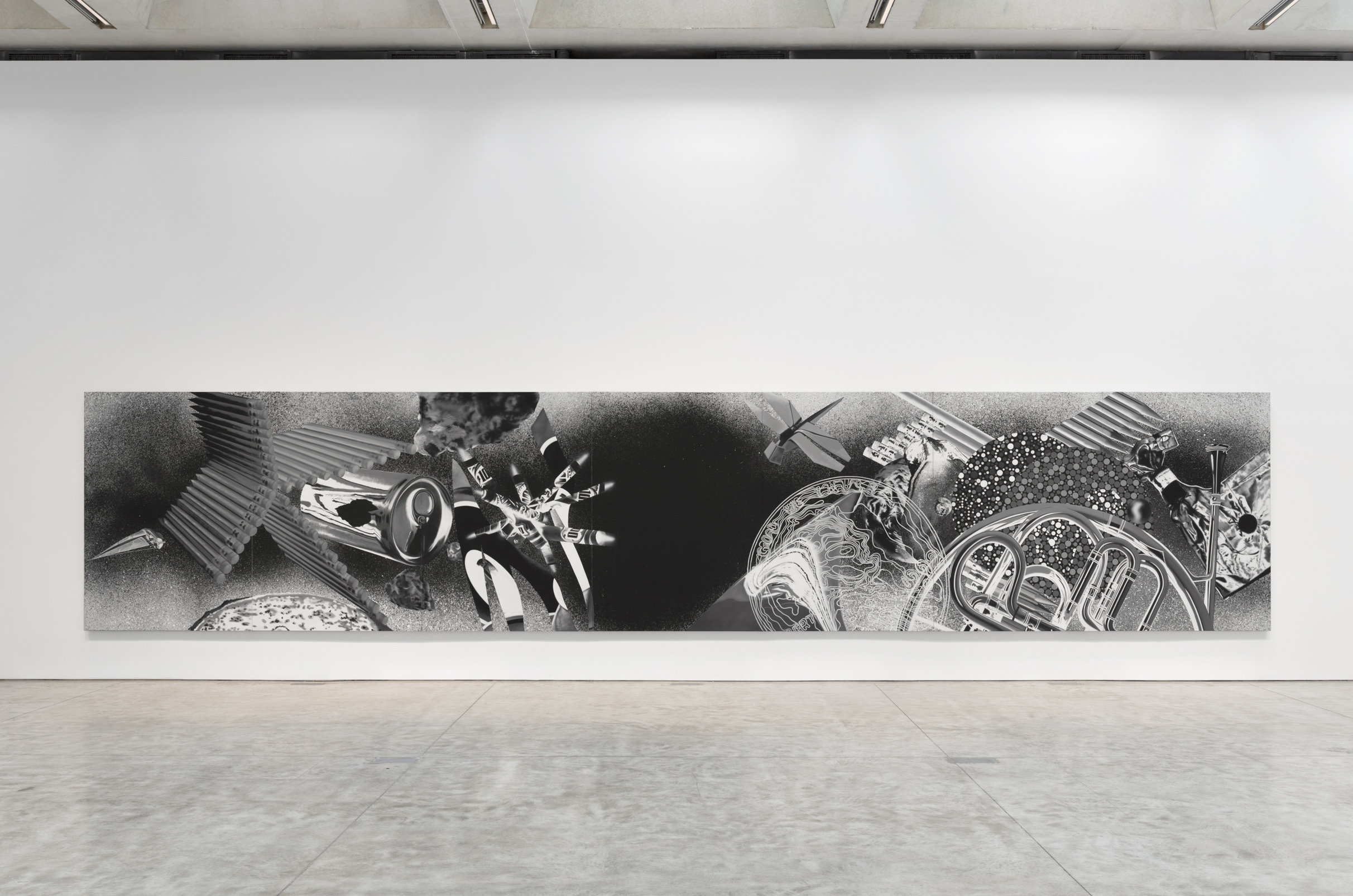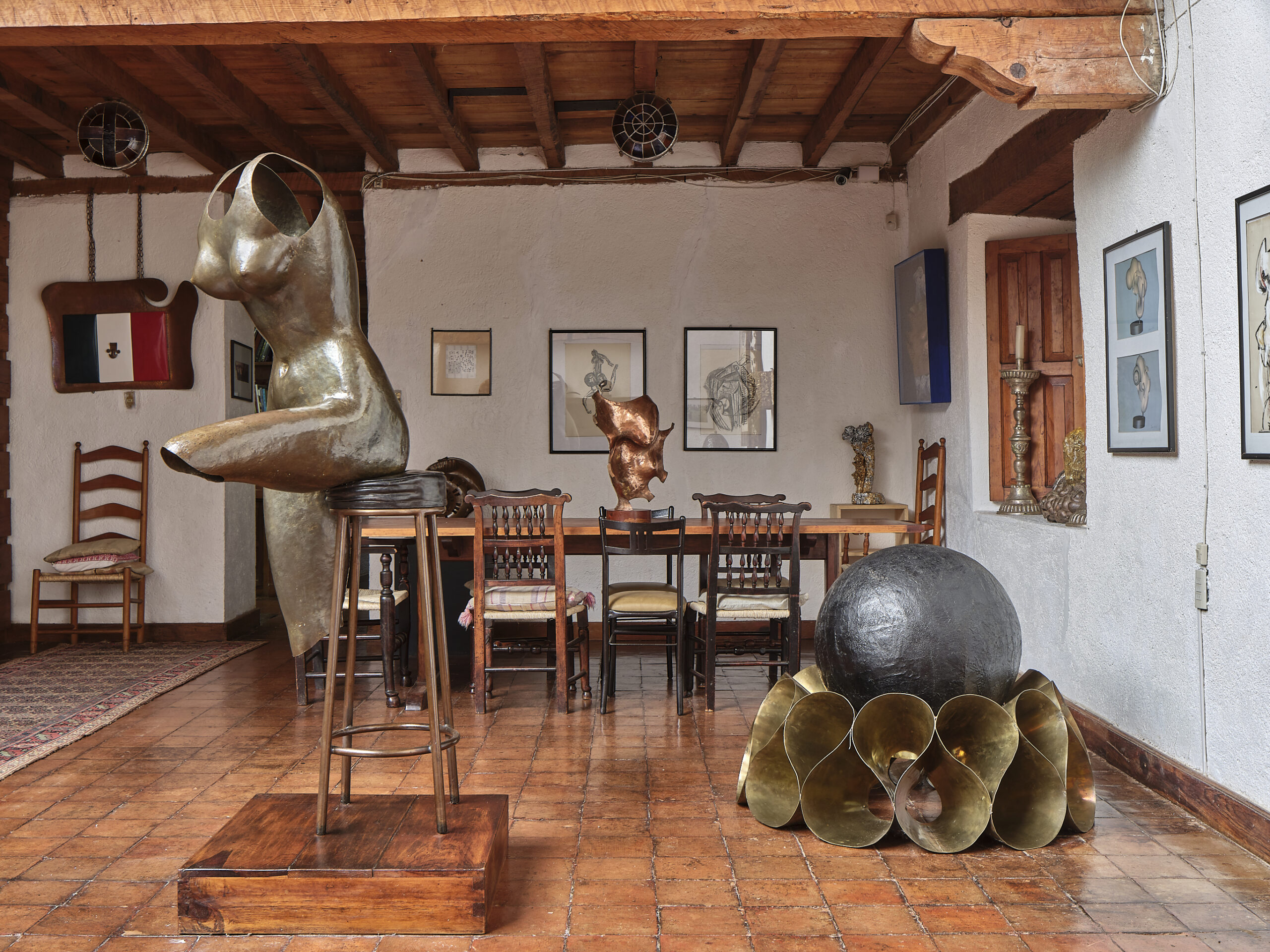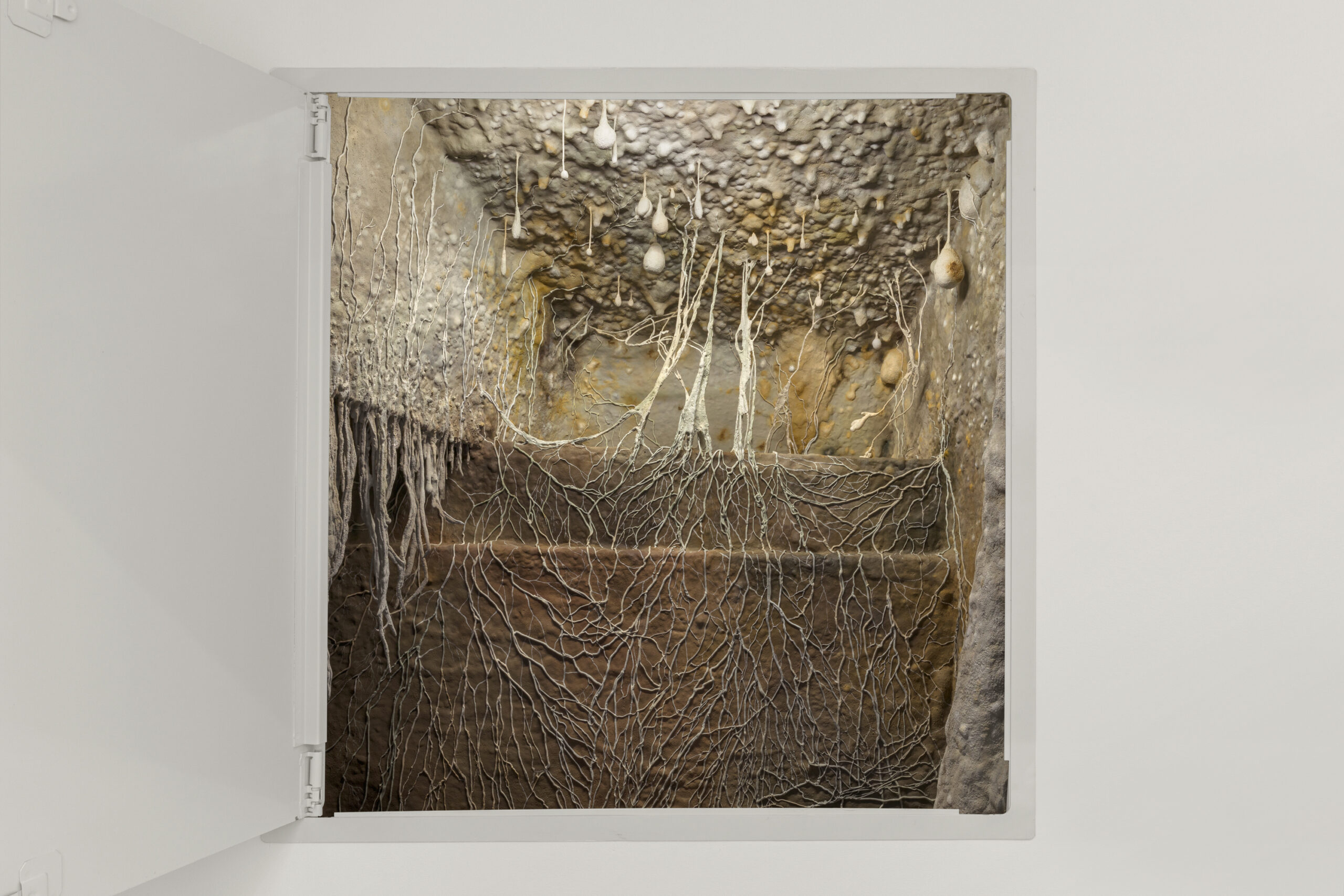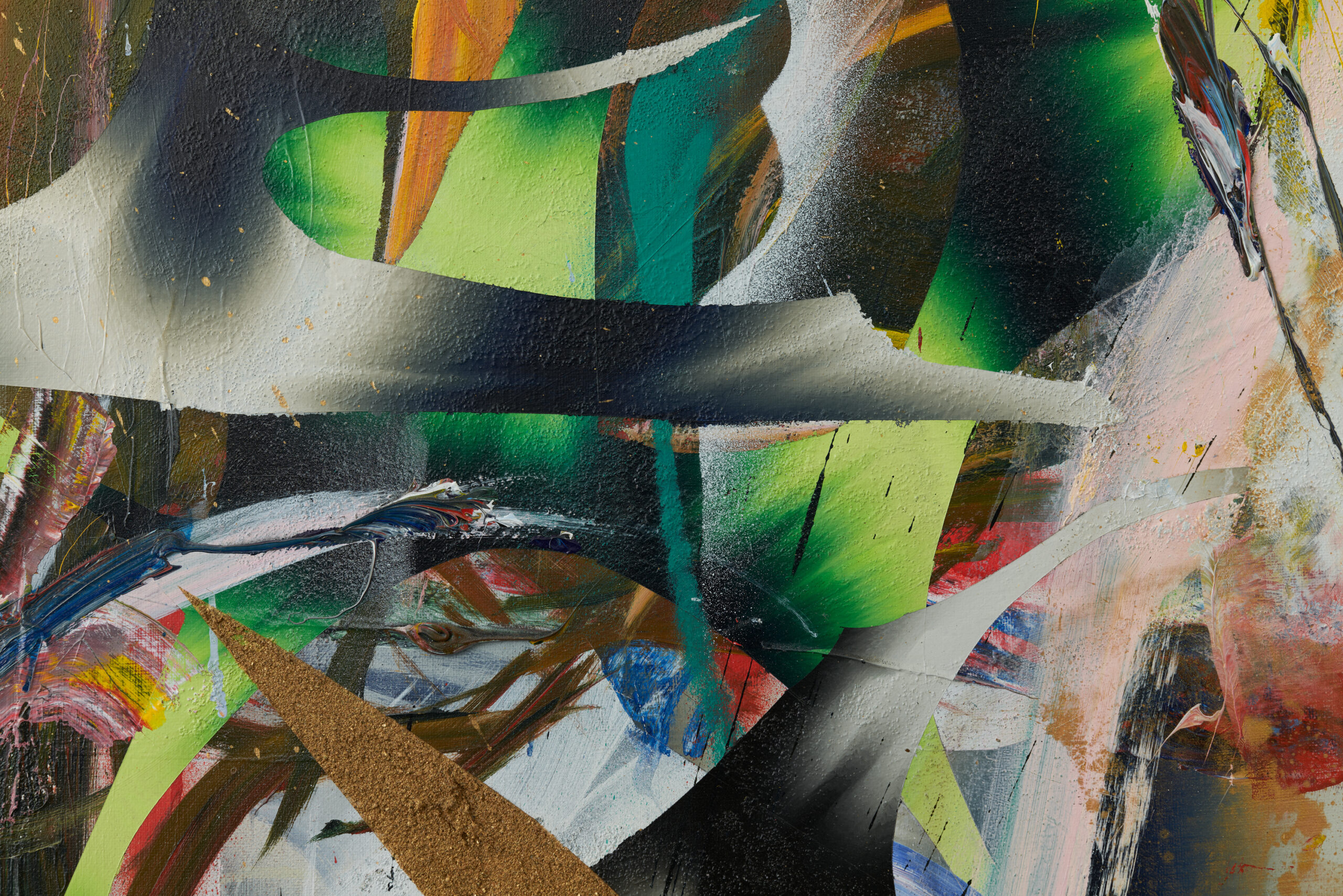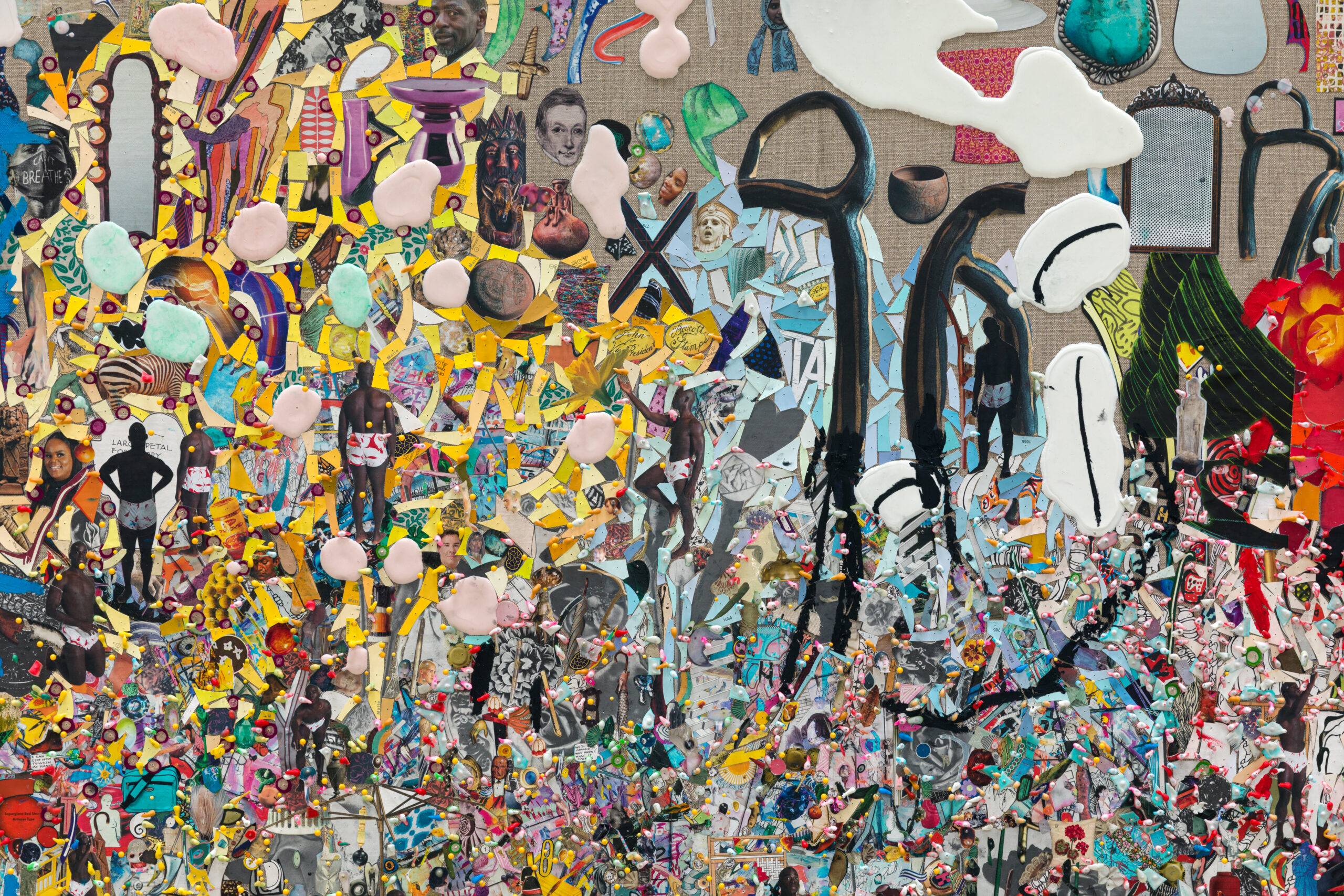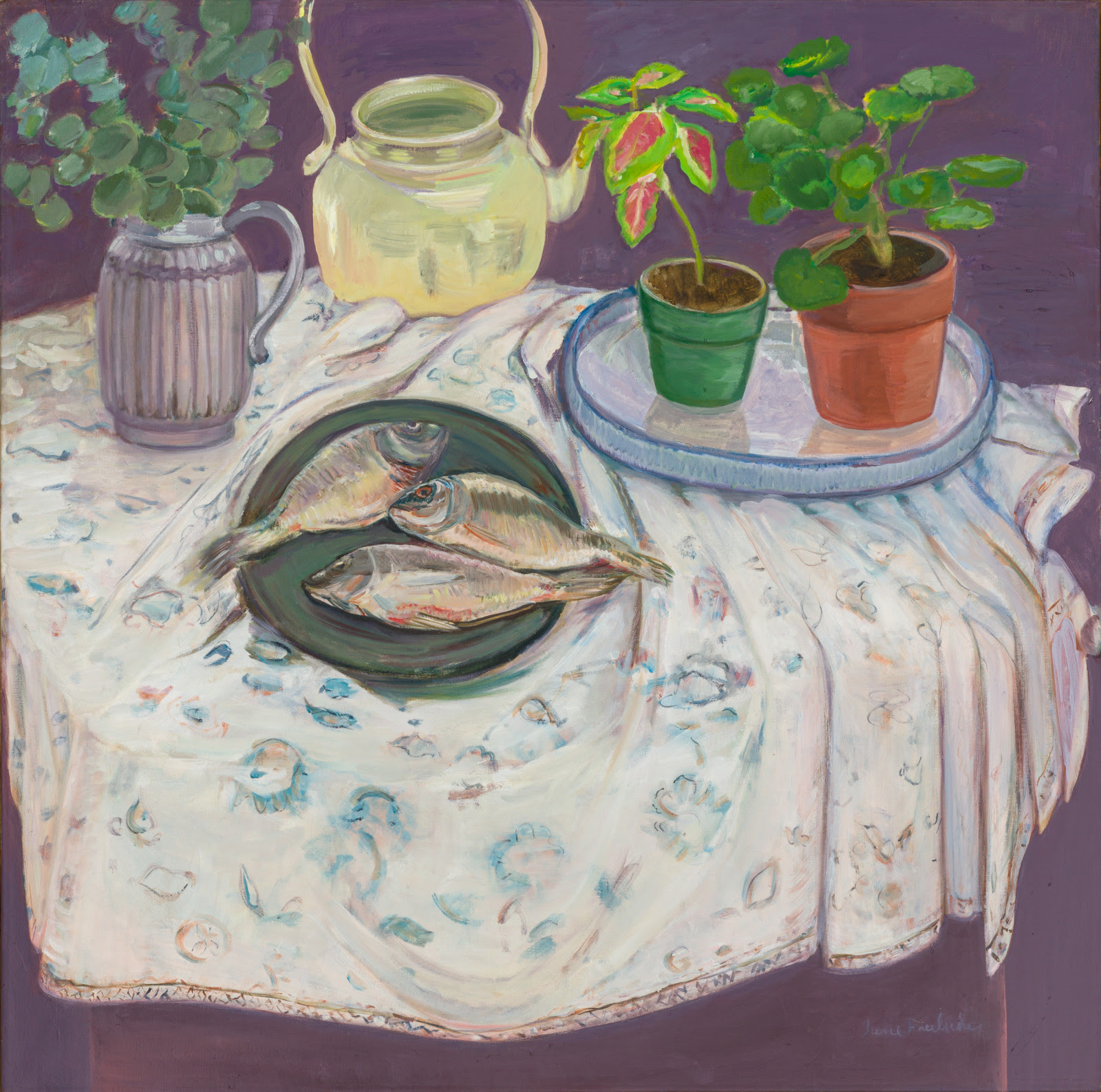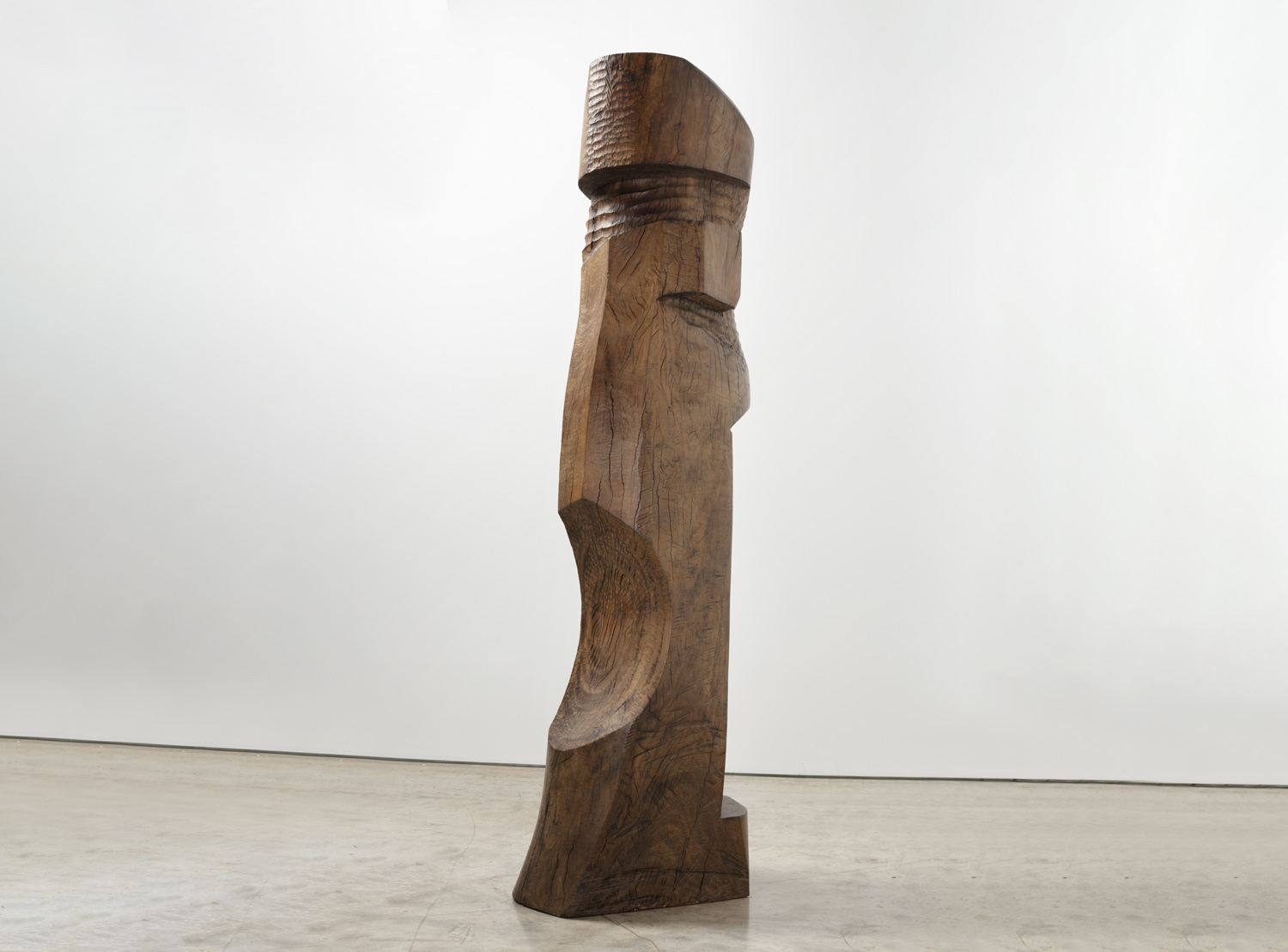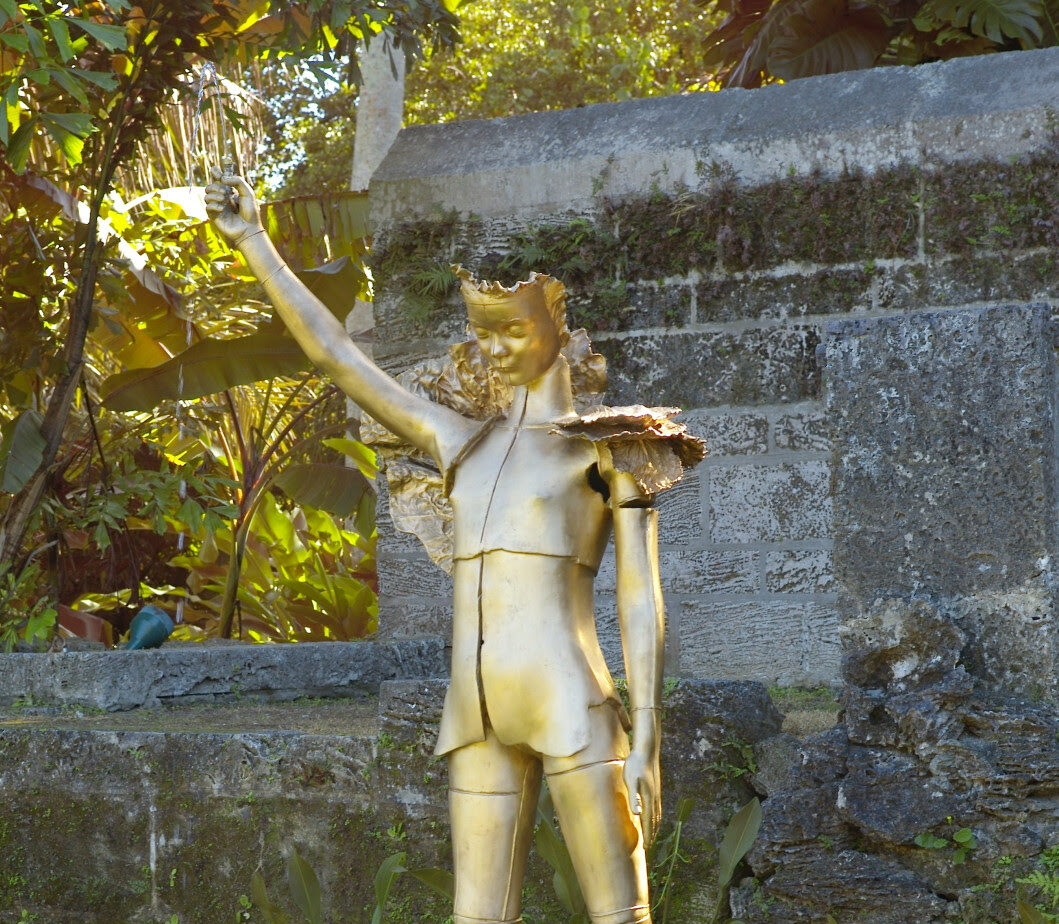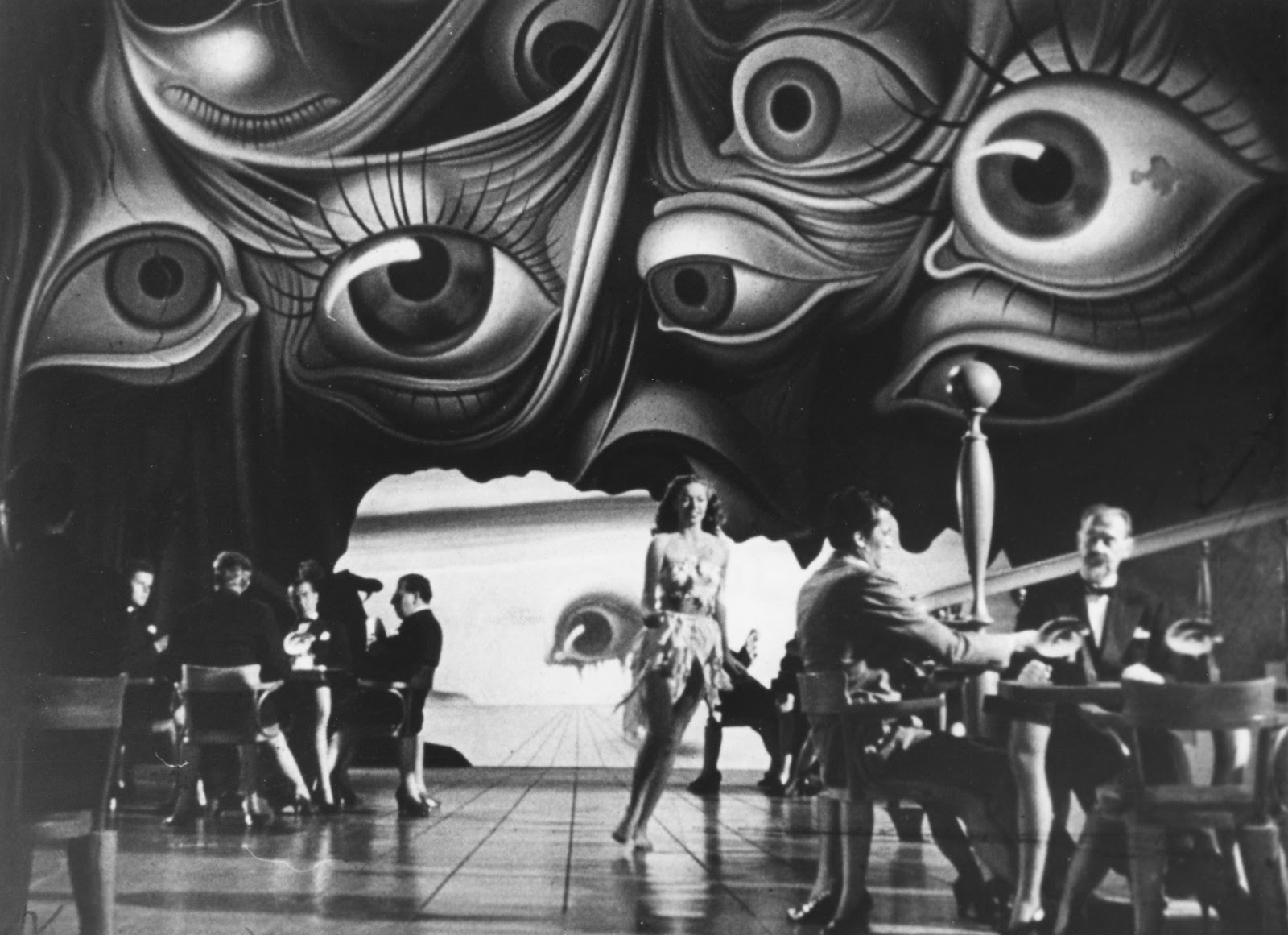On occasional Saturday mornings, Kasmin shares essays and interviews that expand critically on the work and practice of the gallery artists. The below text by Victoria Carruthers is drawn from the catalogue Dorothea Tanning: Doesn't The Paint Say It All?, which brings together three new essays on the artist's practice, each focused on a single work from the recent exhibition of the same title. Carruthers' essay explores Pour Gustave l’adoré (1974), an enigmatic painting revisited by Tanning over several decades. Visit the Kasmin Books site to order a copy of the publication, which features additional contributions from Mary Ann Caws and Kate Conley, as well as a republished text by Dorothea Tanning titled "To Paint".
I first met and interviewed Dorothea Tanning in New York in 2000. I was just starting out on my PhD, enormously fortunate to have the opportunity to meet the artist and, naively, quite unfamiliar with anything other than her early, surrealist-style work. At the end of our meeting, she showed me a reproduction of Pour Gustave l’adoré, a painting from 1974, and asked me what I thought of it. I was immediately captured by the raw sensuality of an image so boldly ambiguous in its representation. I couldn’t make out exactly what I was looking at, yet I had the strong feeling of being lured into a private and unknown world. The figures were so still, defying natural underwater movement, and there was a sense that something or someone was “waiting.” I told the artist that I imagined something looking back at me from the shadowy depths. Tanning, who never attributed a single meaning or interpretation to her works, just smiled and said, “Do you think so? Yes, I agree.” Intrigued as I was, I didn’t realize then what a favor she had done for me. In the years since then, I have come to appreciate the way the artist drew my attention to a work that illustrated her lifelong desire to forge a profound, imaginative, and transformational connection with the viewer.
Throughout her career, Tanning used watery imagery to portray landscapes in a constant state of flux. For her, water represented a liminal space, a threshold in-between realities, and the mermaid was a metaphor for the transformative potential linked to both a bodily and imaginative feminine subjectivity. [1] All of this is evident in her earlier “surrealist” works such as The Truth About Comets (1945), Rêve de Luxe (1944), Sailor’s Dream (1943), or Asleep in the Deep (1947), in which underwater motifs are depicted in landscapes that oscillate between freezing snow and arid desert. In her Self-Portrait of 1944, the artist stands on the edge of a huge canyon familiar to Sedona, Arizona (where she had visited the year before and would soon make a home). However, the dry, red desert earth has been transformed back into the blues and greens of an oceanic world that, in fact, existed eons ago in its geological history. Seen from behind, the artist is wearing a swimming costume and is leaning forward slightly, as if it might be possible to dive in and return to the cool immersion of the ancient water. This surrealist sensibility—a preoccupation with the slippage between one state and another, a fundamental understanding that all realities are potentially simultaneous and contiguous—is a mainstay in Tanning’s imagery. It is elucidated across a range of motifs (doors, wallpaper, cloth) as she experimented with formal techniques from the precise naturalism of the early works through abstraction and her later return to representation.

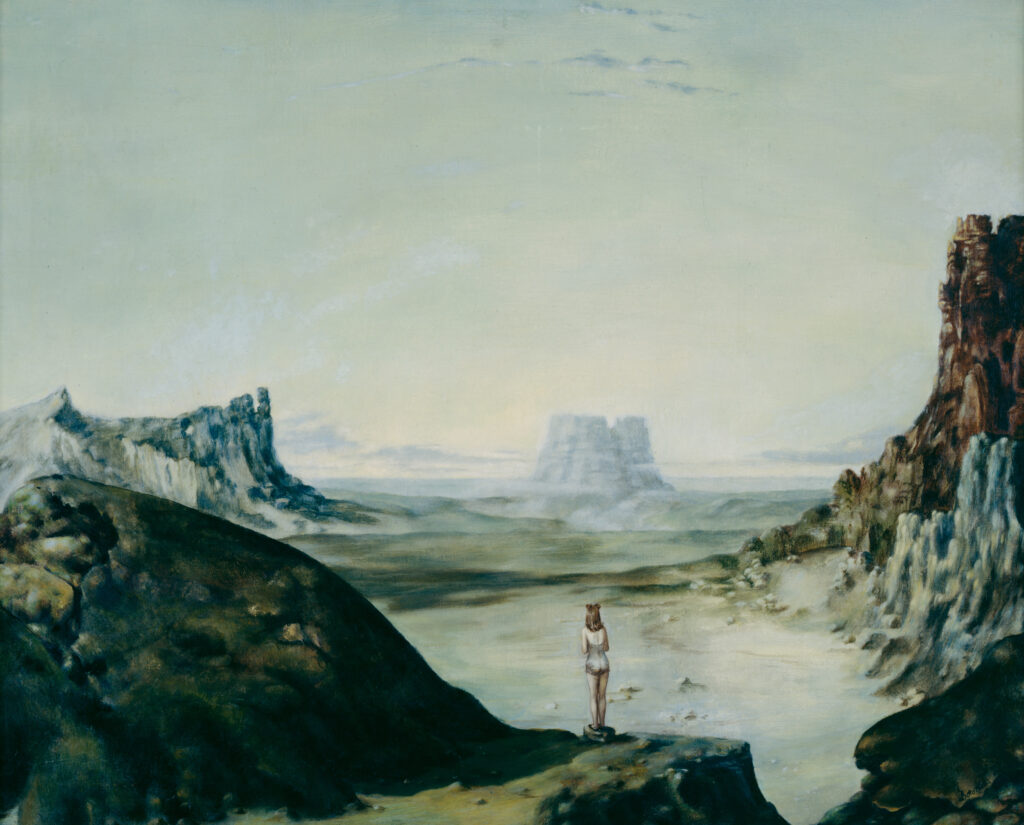
The underwater realm inhabited by the figures in Pour Gustave l’adoré is perhaps her most enigmatic. Made in 1974, this painting is the second in a set of three interconnected, yet separate pieces (with titles alternating between Pour Gustave l’adoré and Dantedoré) begun in 1966 and repeated at eight-year intervals until 1982, when the artist completed the last canvas at the age of 72. Though it was common for Tanning to return to familiar themes, motifs, and imagery, it was quite uncommon to repeat a scene as closely as she did in this series, returning to the same composition with modulations and nuances so subtle that they invite careful examination. Perhaps the most intriguing aspect of these works from the outset is the very thing that caught my attention in her apartment all those years ago: that only a glimpse of the scene is accessible to the viewer, initiating a kind of search for meaning. I suspect that Tanning herself was also searching for something just out of reach, compelling her to return to the scene again and again, in paintings and then in our conversation.
In an important sense, the underwater scene is a space of the unknown. As Tanning herself stated of her works more broadly, she wanted “to capture the moment, to accept it with all its complex identities.” [2] In these works, she raises questions around desire and yearning, connection and isolation, emergence and disappearance, and, ultimately, mortality. Even more, in creating imagery so resistant to a single interpretation by the very fact that we can’t actually “see” what is happening, she dares the viewer to rely in large part upon, and implicitly trust in the power of, their own imagination. Clearly, reductive assessments of her work were at odds with how she saw her own practice when she stated, “unknown but knowable states. I try to capture and paint them.” [3]
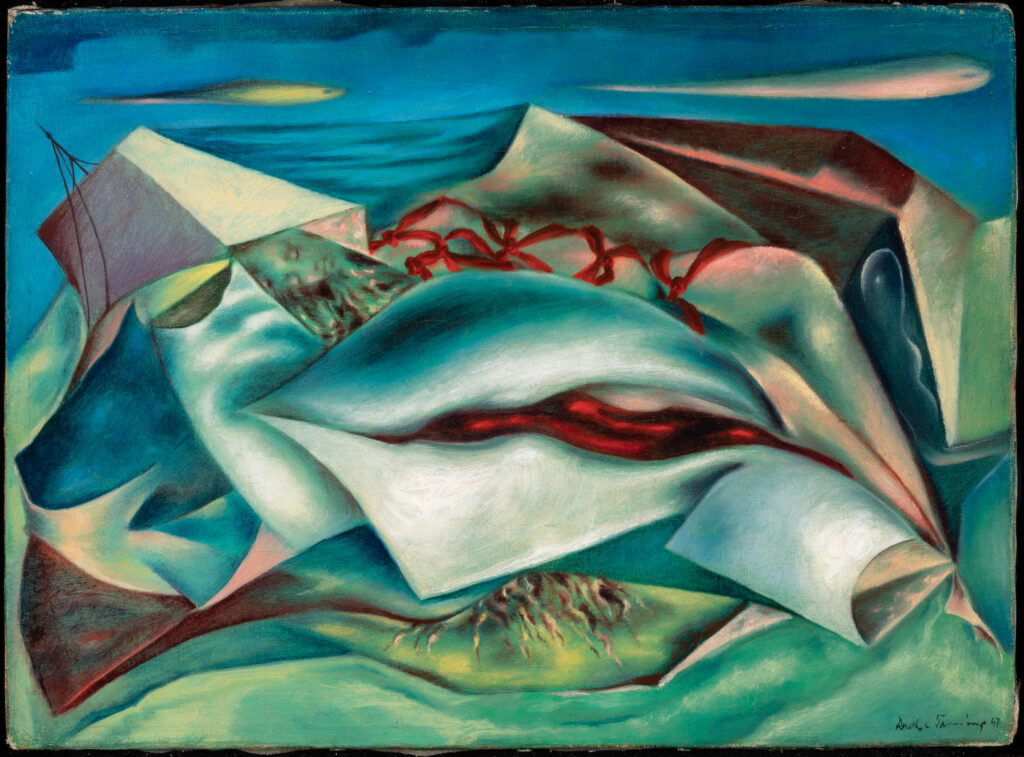
The first of the Pour Gustave l’adoré paintings made in 1966 is small, suggesting it might be a study. The paint seems watery, thin, and applied quickly, while the figure(s) are sketchy, forming only an impression of what is there. Study or not, it is the prelude to a much larger, far more painterly and dramatic work made in 1974. In both, there appears to be the tail of a fish—a mermaid?—surrounded by some human figures who are very hard to make out. These emerge and recede into the layers of paint just as outlines of shadows and objects mutate and transform, at once familiar and recognizable and then amorphous and dissolving, much as they might appear if we were trying to see in the refractions of light in an underwater landscape. The prominent fishtail is a focal point that emerges opalescent, from the dark, velvety deep, into a pool of underwater light. It catches our attention, sparkling and seductive in the water, yet this glimpse is quickly surpassed by our attempt to fathom the expanse of darkness enshrouding the rest of the pictorial space. There is a shift in pace about these two visual registers—first, a quick recognition of the figurative, and then a slower attempt to try to discern something in the abstract void beyond. There is also the sense of weight and stillness in the tail (and by implication in what we can see of the whole figure) which contradicts what we know about the physics of the ocean and its constant flow of movement. We can also see the lower half of the leg of another figure—or maybe it is the human leg of the mermaid, caught shape-shifting between two states. Details of aquatic life—fish tails and sea snakes—seem to teem around the figures but remain submerged in the paint until they pop into our recognition. In the third painting of the set, Dantedoré II, completed in 1982 and only a little smaller than the second, the brilliance and opulence has been toned down. In this final rendition, there is a sense of the figure(s) fading into the depths, retreating on the rhythm of the tide.
The somewhat interchangeable titles of all three works—Pour Gustave l’adoré and Dantedoré—are a play on the name of the 19th century artist, engraver, and illustrator, Gustave Doré, whom Tanning much admired (indeed, the French phrase “l’adoré” means “the beloved one”). [4] Doré is well known for his engravings that illustrate Dante’s Divine Comedy (1320) and Coleridge’s Rime of the Ancient Mariner (1834). Coleridge’s lyrical and elegiac poem was a particular favorite of Tanning’s, and there is a distinct confluence between some of the poetic imagery in both literary works and Tanning’s 1974 painting. For example, in the Mariner we read:
Beyond the shadow of the ship
I watched the water-snakes:
They moved in the tracks of shining white,
And when they reared, the elfish light
Fell off in hoary fakes.
Within the shadow of the ship
I watch their rich attire:
Blue, glossy green, and velvet black,
They coiled and swam; and every track
Was a flash of golden fire.
The sumptuous imagery of life, coiled and slippery, gliding through the “glossy green” and “velvet black” of the water evokes both the rich surface and the sublime literal and psychological depths of the painting.
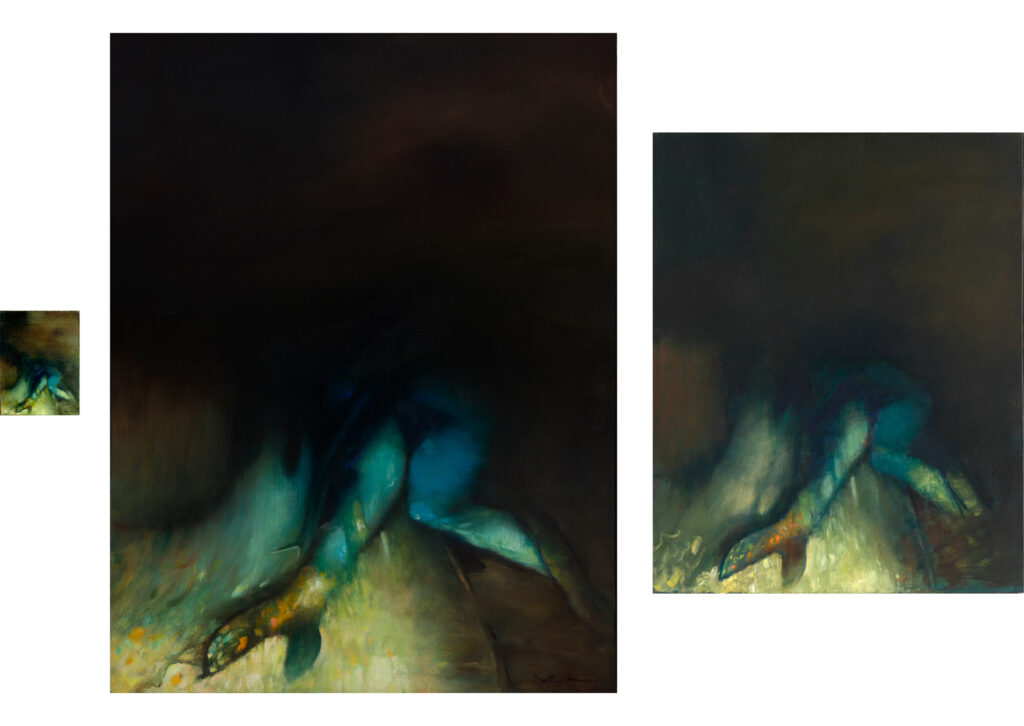
(Center) Dorothea Tanning, Pour Gustave l’adoré, 1974, oil on canvas, 45 5/8 x 35 inches, 115.9 x 88.9 cm. The Destina Foundation, New York.
(Right) Dorothea Tanning, Dantedoré II, 1982, oil on canvas, 31 7/8 x 25 5/8 inches, 81 x 65.1 cm. Private Collection.
The three canvases may also have been influenced by the form and substance of Dante’s Divine Comedy. After all, Dante’s epic poem, written in three parts, narrates a guided journey from Hell to Heaven via Purgatory. This second book, Purgatory, begins at Canto 19 with a sequence known as the “Dream of the Siren,” filled with vivid aquatic imagery in which we, the readers, are cautioned against being seduced by images which are mere projections of our own desires. The context here is, of course, the Renaissance conundrum of sin, death, and redemption, but both Dante’s and Coleridge’s poems create hybrid worlds full of mutability and flux. Both are tales of journeying in search of truth, against the odds of human frailty and moral blindness. In these paintings, as is the case in much of her work, Tanning creates realms of the imagination in which animal and human, the earthly and the supernatural, and the real and the imagined can easily co-exist. These ambiguities pervade the three paintings as they resist the constraint of definitive meaning and invite the companionship of an open mind.
The visceral sensuality of the 1974 version has been replaced in the 1982 painting by a more indistinct and blurrier image. The predominance of vertical brushstrokes gives a sense that the foreground is being pushed back, receding into the water. Despite this, the figures are discernible: a nearby fishy tail is replaced by what looks like hunching shoulders seen from behind, while the figure on the right is visibly bending around the “mermaid” in a gesture of protection and familial connection, a gesture prominent in Tanning’s work at that time. In Dantedore II, the figures blend and merge with each other in a way that does not differentiate them from surrounding water which seems to be murkier than ever, as if stirred up and made cloudy with silt.
When I first noticed these figures emerging from the watery shadows in Dantedore II, I was struck by the idea that maybe they were there as a group all the time, and I had just been unable to see them. Once I did, it was hard not to see these three paintings in a greater narrative arc, one that closely resembles the cycle of life: the earliest 1966 work initiates a beginning, the velvet viscosity and lush sensuality of the 1974 version suggests the rich drama of life, and the 1982 figures finally resolve and fade away. This connection, coupled with the temporal relationship between the images, implies a continuum of “sea-changes,” a circular relay of emergence and disappearance and the possibility of births and deaths, of multiple returns. As such, they represent the very acts of creativity—real, imagined, spectacular, or mundane.
In her painting, Tanning speaks to the nature of the forces of creativity and to the importance of the relationship between the imagination of the artist and the viewer. In her writing, she positions herself as Divine creator, yet always with the wise understanding that her creations are sovereign entities that, once “born,” live well beyond their maker. For Tanning, her work formed part of a creative continuum not defined by beginnings or endings but living in the endless potential of the imagination. In her own words:
The canvas lies under my liquid hand. Explosia, a new planet invented with its name. “That’s what we paint for, invention” […] Because this is only the beginning. A long flashed life, as they say, before dying. [5]
Returning to these lines from 1986 in 2001, she composed the perfect metaphor for her creative process:
I am a fish swimming upstream. At the very top I deposit my pictures; then I die as they ripen and hatch and swim down, very playfully, because they are young and full of big ideas. Down and down and, finally, among the people who like to fish pictures, they are caught and devoured by millions of eyes. [6]
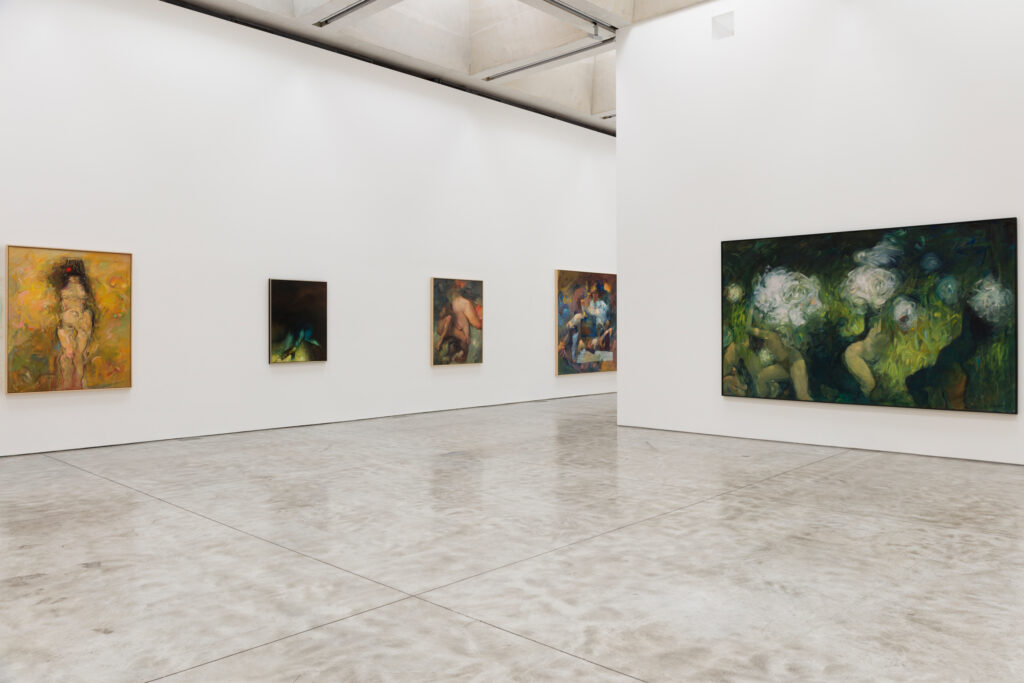
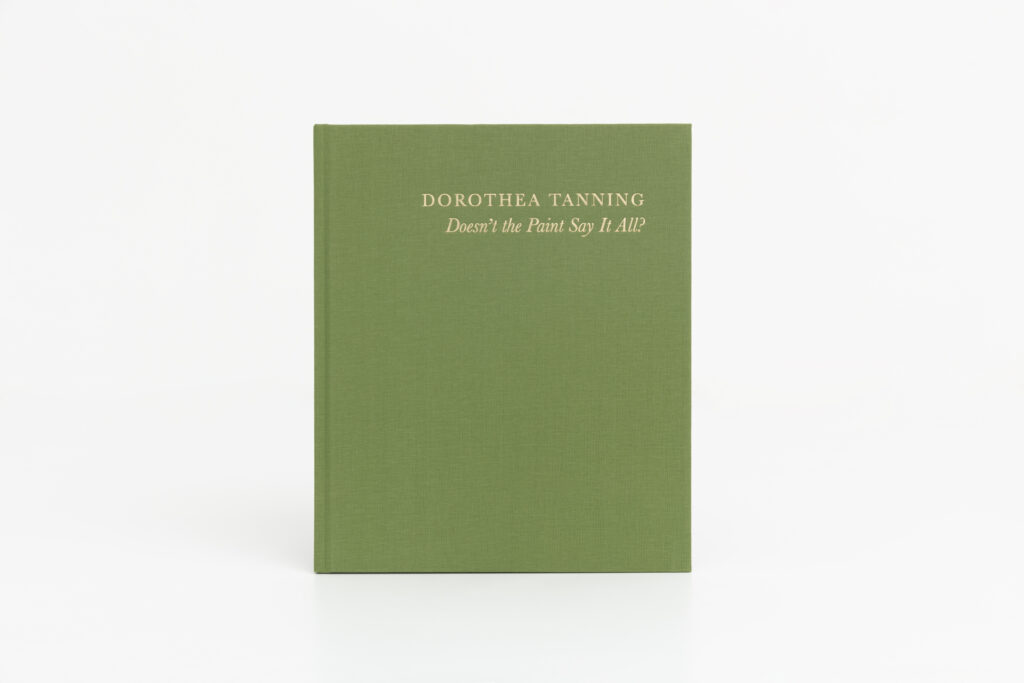
Victoria Carruthers is Senior Lecturer in modern and contemporary art history and theory at the Australian Catholic University, Sydney, Australia. Her research interests focus on the intersections between visual art, literature, poetry and music across modern and contemporary cultures. She completed her doctoral thesis on the work of Dorothea Tanning and has written articles on her practice including “Between Silence and Sound: John Cage, Karlheinz Stockhausen and the Sculptures of Dorothea Tanning” in Art, History and the Senses: 1830 to the Present (Patrizia Di Bello and Gabriel Koureas, eds. Surrey: Ashgate Publishing, 2010, pp. 97-116) and “Dorothea Tanning and Her Gothic Imagination” in the Journal of Surrealism and the Americas 5: 1 (2011, pp. 134-158). She has recently published the monograph Dorothea Tanning: Transformations (London: Lund Humphries, 2020).
[1] For a further discussion of Tanning’s mermaid and water imagery, see Victoria Carruthers and Catriona McAra, “Mermaids and Metaphors: Dorothea Tanning’s Surrealist Ocean,” in Framing the Ocean, 1700 to the Present: Envisaging the Sea as Social Space, ed. Tricia Cusack (Surrey: Ashgate Publishing Ltd., 2014): 211-222.
[2] Dorothea Tanning, quoted in Alain Jouffroy, “Interview with Dorothea Tanning,” in Dorothea Tanning, exh. cat. (Malmö: Malmö Konsthall, 1993): 57. Originally published as “Questions pour Dorothea Tanning entretien avec Alain Jouffroy, Mars 1974,” in Dorothea Tanning: Oeuvre, exh. cat. (Paris: Centre National d’Art Contemporain, 1974).
[3] Tanning, in Jouffroy, “Interview,” 57.
[4] Tanning purchased Doré’s large oil painting of nereids, Les Océanides (c. 1860), in 2001.
[5] Dorothea Tanning, Birthday (San Francisco: Lapis Press, 1986): 165.
[6] Dorothea Tanning, Between Lives: An Artist and Her World (New York: W.W. Norton, 2001): 317.

